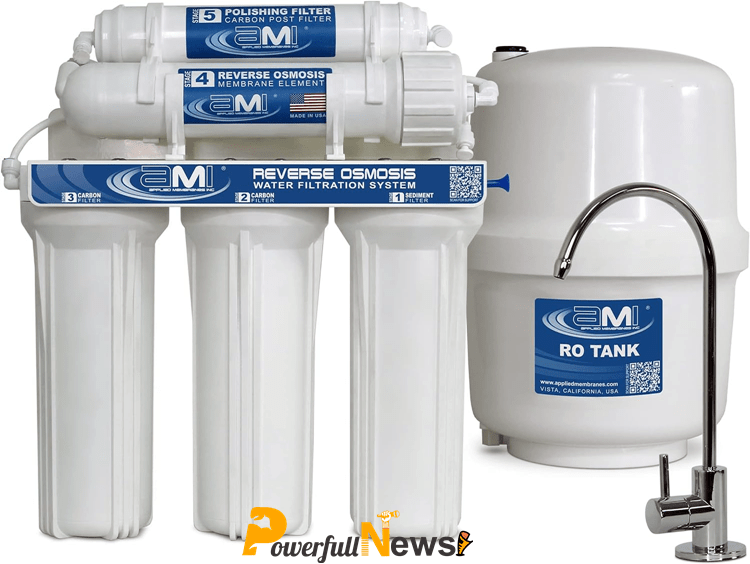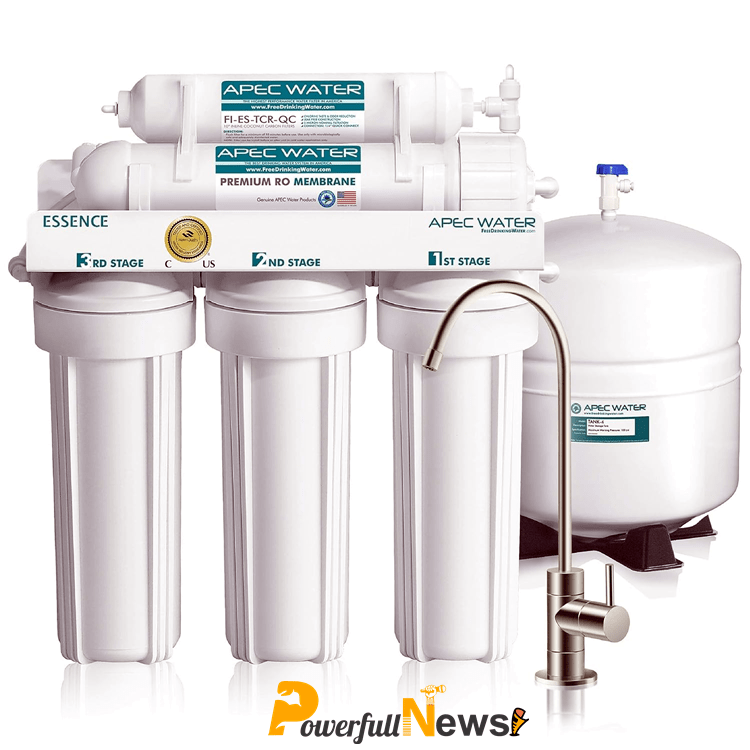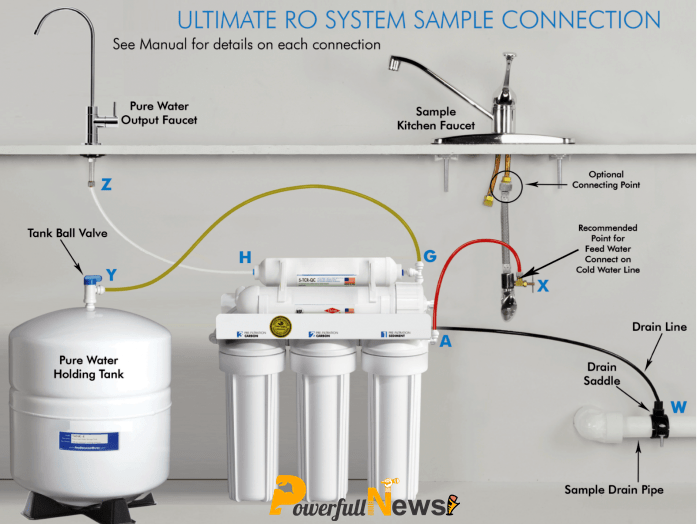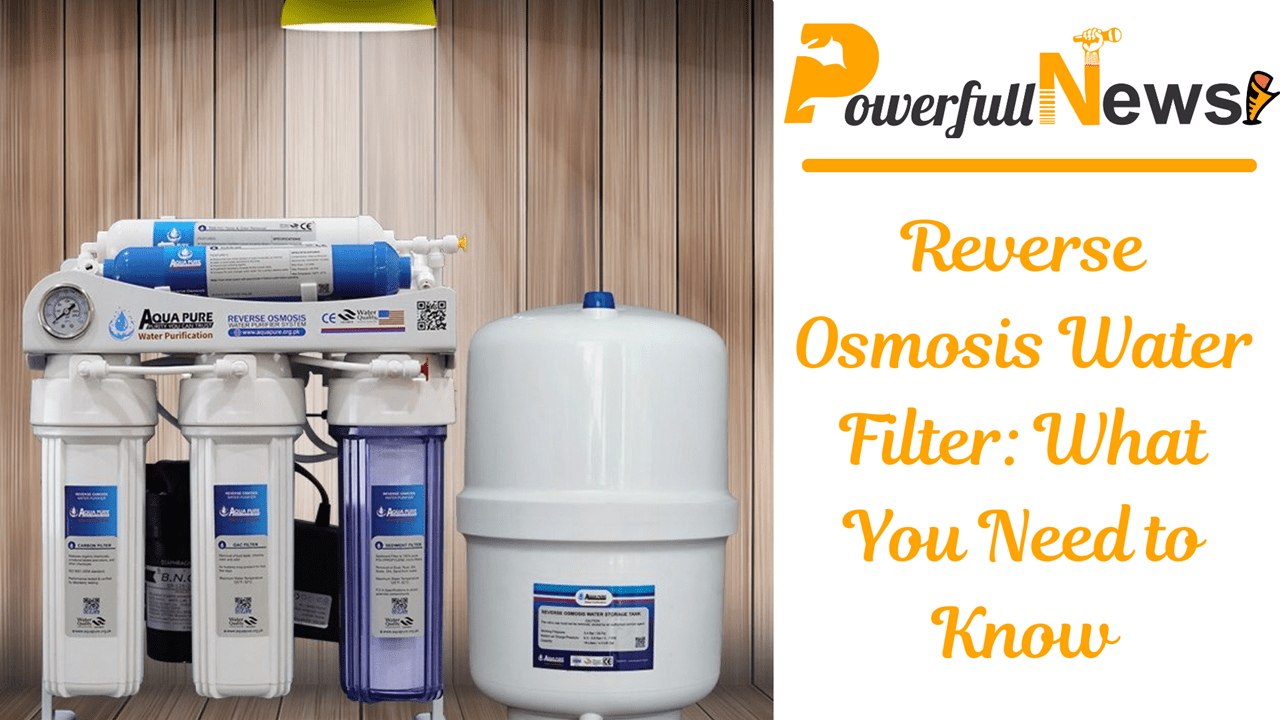Are you tired of worrying about the water quality you’re drinking? Reverse osmosis (RO) water filters have become increasingly popular for providing clean drinking water. This advanced filtration technology can effectively remove many contaminants, including heavy metals, bacteria, viruses, and even dissolved solids.
A reverse osmosis (RO) water filter is one of the most efficient systems for removing contaminants from drinking water. Using a semipermeable membrane, RO systems can filter harmful substances such as lead, arsenic, fluoride, chlorine, and bacteria.
In this comprehensive guide, we’ll explore the benefits and drawbacks of reverse osmosis water filters and how to choose the right system for your needs.
Understanding Reverse Osmosis Water Filtration
Reverse osmosis is a top-notch way to clean water. It uses a special membrane to remove many contaminants. This method is widely used to make water safe for homes, businesses, and industries.
What is Reverse Osmosis?
This method cleans water by pushing it through a special filter. The filter lets water molecules through but stops other stuff like salts, minerals, and germs. It’s a smart way to keep water clean.
How Does Reverse Osmosis Work?
First, a pump pushes water into the system. Then, the water goes through a semi-permeable membrane. This membrane keeps out the bad stuff, letting only clean water through.
Clean water is collected, and waste is thrown out. This process removes heavy metals, chemicals, and germs, making the water safe and pure.

Benefits of Reverse Osmosis Water Filter
Reverse osmosis water filters are great for homeowners who want cleaner drinking water. They remove contaminants like heavy metals, minerals, and chemicals, making the water taste better and healthier.
These systems also make the water very pure. They take out dissolved solids and other impurities. This means the water is of the highest quality, often better than what laws require. Drinking this water can help keep you healthy by reducing the risk of harmful substances.
| Benefit | Description |
|---|---|
| Contaminant Removal | The reverse osmosis process produces exceptionally pure water, often exceeding regulatory standards for water quality, contributing to a healthier drinking experience. |
| Water Purity | Reverse osmosis filters can significantly improve the taste of drinking water by removing impurities, making it more enjoyable to consume. |
| Better Taste | By removing impurities, reverse osmosis filters can significantly improve the taste of drinking water, making it more enjoyable to consume. |
Reverse osmosis water filters also improve your health. They reduce contaminants, which lowers the risk of health problems. If you’re worried about your tap water or want better-tasting water, a reverse osmosis filter is a smart choice for your home.
Components of a Reverse Osmosis System
A reverse osmosis (RO) system is a detailed water filtration solution. Its key parts work together to give you clean, purified water. Knowing what each part does helps you understand how the whole system works.
Pre-filters
The pre-filters are the first step in an RO system. They remove contaminants like sediment, rust, and dirt, keeping the RO membrane from getting clogged or dirty too quickly. Most RO systems have several pre-filters, each targeting different contaminants.
Reverse Osmosis Membrane
The reverse osmosis membrane is the system’s core. It’s a semi-permeable barrier that removes up to 99% of dissolved solids, including minerals, metals, and microorganisms. Water passes through the membrane under pressure, leaving contaminants behind for clean water.
Storage Tank
The storage tank holds the purified water until you need it. It ensures you always have filtered water, even when used a lot. The tank’s size depends on your household’s needs.
These parts work together to make a reliable RO system. They provide high-quality, clean water for drinking, cooking, and other uses at home or in industries.
Reverse Osmosis Water Filter
A reverse osmosis (RO) water filter is a top choice for clean drinking water at home. These systems remove many contaminants, giving you and your family great-tasting water.
There are different types of RO filters to fit your needs. Under-sink models are popular because they fit under your kitchen sink, saving counter space. Whole-house RO systems clean all your water, ensuring pure drinking, cooking, and bathing water.
| Feature | Under-Sink RO Filter | Whole-House RO System |
|---|---|---|
| Installation Location | Beneath Kitchen Sink | Whole-House |
| Water Purification | Drinking Water | Entire Home |
| Filtration Capacity | It may require more extensive maintenance | Varies based on system size |
| Maintenance | Easier to access and maintain | May require more extensive maintenance |
When picking an RO filter, consider your home’s water use, the contaminants in your water, and where you’ll install it. Making an informed choice means enjoying the many perks of a top-notch reverse osmosis water filter. These include better taste, less odor, and fewer harmful substances like lead, arsenic, and fluoride.
Installation and Maintenance
Installing and maintaining a reverse osmosis water filter system is key for its best performance and long life. Where you put the system matters a lot. It affects how well it works and how easy it is to use.
Where to Install a Reverse Osmosis System?
Most people put reverse osmosis systems under the kitchen sink. This spot makes changing filters and doing maintenance easy and saves counter space in the kitchen. But you could also put it in a utility room or basement. Remember, it might need longer tubing and be harder to get to.
Maintenance and Replacement Schedule
Keeping a reverse osmosis water filter system in good shape means constantly changing filters and doing upkeep. The pre-filters need changing every 6-12 months to catch big particles and contaminants. The reverse osmosis membrane, the system’s core, should be replaced every 2-5 years, based on how much you use it and your water’s quality. Not changing these parts can make the water taste bad, and the system works poorly.
Follow the manufacturer’s maintenance schedule and change worn-out parts quickly. This will ensure that your reverse osmosis system continues to provide clean, great-tasting water for many years.

Water Quality and Contaminant Removal
Reverse osmosis water filters are known for their top-notch ability to remove many contaminants from water, ensuring clean, safe drinking water. They use advanced membrane technology to remove heavy metals, minerals, and chemicals.
Types of Contaminants Removed
These filters are great at taking out a wide variety of contaminants, including:
| Contaminant | Removal Efficiency |
|---|---|
| Heavy Metals (lead, mercury, arsenic) | Up to 99% |
| Minerals (calcium, magnesium, sodium) | Up to 99% |
| Chemicals (chlorine, pesticides, herbicides) | Up to 99% |
| Bacteria and Viruses | Up to 99% |
| Fluoride | Up to 95% |
These filters greatly remove contaminants, making the water safe for drinking, cooking, and other uses. Choosing reverse osmosis is smart for anyone wanting better water quality, contaminant removal, and water purification at home. Using membrane filtration technology also boosts drinking water safety.
“Reverse osmosis is one of the most effective water purification methods available, capable of removing up to 99% of contaminants from your drinking water.” Water Quality Association
Selecting the Right Reverse Osmosis System
Choosing the right reverse osmosis system for your home is key. You must consider your household’s water use, the system’s size, and the water quality problems you want to fix. This guide will help you pick the best system for your needs.
First, look at your water use. Think about how many people live with you and how much water they use daily. This will help you pick the right system size. Big families need systems that can handle more water. Also, consider any extra water use, like watering your garden or filling a pool, to ensure the system can do everything.
Then, check the water quality issues you want to fix. Reverse osmosis systems greatly remove many contaminants, such as heavy metals, dissolved salts, and germs. Knowing what’s in your water will help you pick a system that makes your water safe and clean.
| Key Factors to Consider | Importance |
|---|---|
| Choosing reverse osmosis system | Selecting the right system based on your household’s water usage and quality needs is crucial for optimal performance and efficiency. |
| System size | Choosing a system with the appropriate capacity to meet your household’s water demands is essential for ensuring reliable and consistent water supply. |
| Flow rate | Ensuring the system has a sufficient flow rate to keep up with your household’s water usage is important for maintaining a steady supply of filtered water. |
| Water usage | Considering your household’s overall water usage, including any special needs, is crucial for selecting a system that can handle your total water demands. |
| Water quality | Evaluating the specific water quality issues in your area will help you choose a system with the appropriate filtration capabilities to address your water concerns. |
Consider these factors to pick a reverse osmosis system that meets your needs now and in the future. It will provide reliable, high-quality filtered water.
Pros and Cons of Reverse Osmosis Filtration
Reverse osmosis is a top-notch water purification tech that can remove many contaminants from drinking water. But it’s not perfect and has both good and bad sides.
Pros
- Eliminate up to 99% of many impurities
- Protect from dissolved salts
- Helps to separate heavy metals And germs
- It’s a greener and cheaper way to get clean water
Cons
- Filter replacement is so challenging
Comparing Reverse Osmosis to Other Filtration Methods
Reverse osmosis is just one way to purify water. It’s great at removing many contaminants. But how does it stack against other methods like carbon filters and ion exchange systems?
Carbon filters greatly remove organic matter, chlorine, and some heavy metals. They’re also cheaper and easier to maintain than reverse osmosis systems. However, they might not catch dissolved salts, nitrates, or tiny particles.
Ion exchange systems are excellent at removing hard minerals, heavy metals, and some salts. They’re a smart pick if your water is very hard. However, they might struggle with organic matter and tiny bugs.
| Filtration Method | Contaminant Removal | Cost | Maintenance |
|---|---|---|---|
| Reverse Osmosis | Comprehensive, removes a wide range of contaminants | Moderate to high | Moderate |
| Carbon Filters | Effective for organic compounds, chlorine, and some heavy metals | Low to moderate | Low |
| Ion Exchange | Effective for hardness minerals, heavy metals, and dissolved salts | Moderate | Moderate |
Choosing a water filter depends on what’s in your water, your budget, and how much upkeep you’re okay with. Knowing what each filter does best helps you pick the right one for your needs.

Cost and Efficiency Considerations
Investing in a reverse osmosis water filtration system involves considering the upfront cost and ongoing expenses. The initial cost might be higher than other options, but the long-term benefits make it a smart choice for many homeowners. The price of a reverse osmosis system varies greatly. It depends on your home’s size, the number of stages, and the quality of the parts. Basic systems cost between $200 and $500, not including installation. But advanced systems with extra features can go over $1,000.
Homeowners need to consider the ongoing costs, too. Reverse osmosis systems use more energy because they need pressure to filter water, which can increase electricity bills. However, some energy-efficient models can help lower these costs. Another thing to consider is the water waste from reverse osmosis. This method can waste up to 4 gallons of water for every gallon filtered. While this water can be used for other things in your home, it’s still something to consider when evaluating efficiency.
Consider the long-term benefits when evaluating the cost and efficiency of a reverse osmosis system. These include better water quality, taste, and health and safety. By weighing these factors, homeowners can decide if a reverse osmosis system is right for their home.
Conclusion
A reverse osmosis water filter can greatly improve your home’s water purification. By learning about the technology, benefits, and things to consider, you can decide if it’s right for your home. This choice is key to better water quality improvement and home filtration solutions.
Reverse osmosis is a top-notch way to clean water. It removes many contaminants, giving your family clean water to drink. The system has parts like pre-filters, a reverse osmosis membrane, and a storage tank. These work well together to improve water quality and give you a steady supply of clean drinking water.
When picking a reverse osmosis system, consider installation, upkeep, and what contaminants you want to remove. By looking at the good and bad sides and comparing it with other options, you can find the best reverse osmosis water filter for your needs. This way, your home gets to enjoy clean, purified water.
FAQs About Reverse Osmosis Water Filter
What is a reverse osmosis water filter?
A reverse osmosis water filter is a top-notch system for cleaning water. It uses a special membrane to remove contaminants such as minerals and heavy metals, making the water cleaner and safer to drink.
How does a reverse osmosis system work?
This system forces water through a special membrane under pressure. The membrane catches the bad stuff, leaving clean water behind. This clean water is then ready for you to use.
What are the benefits of using a reverse osmosis water filter?
These filters are great because they remove many contaminants. They make your water taste better and healthier to drink. They also help your appliances last longer by reducing mineral buildup.
What are the key components of a reverse osmosis system?
A reverse osmosis system has pre-filters, a special membrane, and a storage tank. Together, they ensure the water is fully cleaned and ready for use.
How do I choose the right reverse osmosis system for my home?
Consider your home’s water needs, the system’s size, and the contaminants you want to remove. Also, consider how easy it is to install and maintain the system.
What types of contaminants can a reverse osmosis system remove?
These systems are excellent at removing heavy metals, minerals, and chemicals. They can remove lead, arsenic, fluoride, and chlorine.
What are the pros and cons of using a reverse osmosis system?
They remove many contaminants and make water taste better, which are good things. However, they use energy and wastewater and need regular upkeep and filter changes.
How do reverse osmosis systems compare to other water filtration methods?
Reverse osmosis is often seen as the best way to filter water, beating out other methods like carbon filters. But the best system for you depends on your water quality needs and what you prefer.
What are the cost and efficiency considerations for a reverse osmosis system?
These systems can cost more upfront but offer long-term benefits and better water quality. When evaluating their cost and efficiency, consider energy use and water waste.



